Noticias del mercado & perspectivas
Anticípate a los mercados con perspectivas de expertos, noticias y análisis técnico para guiar tus decisiones de trading.

Most traders understand EA portfolio balance through the lens of traditional risk management — controlling position sizes, diversifying currency pairs, or limiting exposure per trade.
But in automated trading, balance is about deliberately constructing a portfolio where different strategies complement each other, measuring their collective performance, and actively managing the mix based on those measurements.
The goal is to create a “book” of EAs that can help diversify performance over time, even when individual strategies hit rough patches.
A diversified mix of EAs across timeframes and assets can, in some cases, reduce reliance on any single strategy. This approach reduces dependency on any single EA’s performance, smooths your overall equity curve, and builds resilience across changing market conditions.
It’s about running the right mix, identifying gaps in your coverage, and viewing your automated trading operation as an integrated whole rather than a collection of independent systems.
Basic Evaluation Metrics – Your Start Point
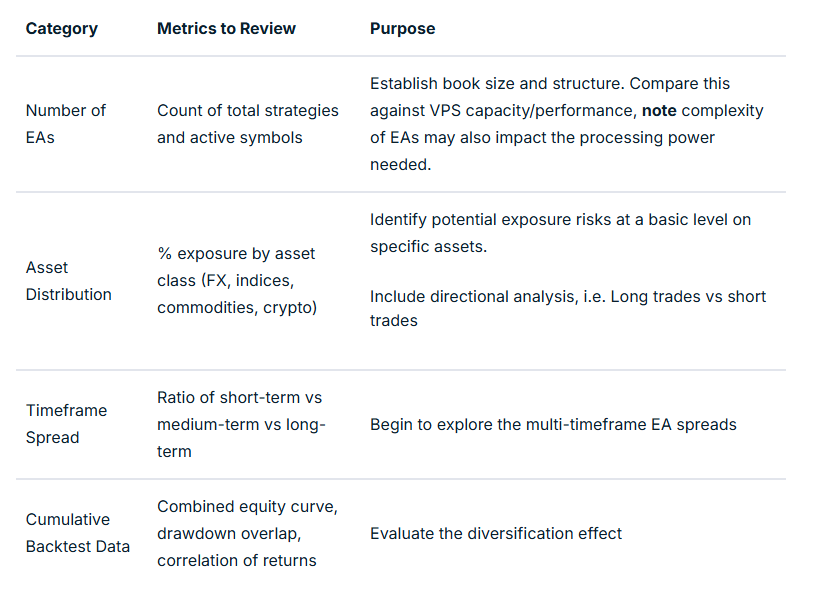
Temporal (timeframe) Balancing
When combined, a timeframe balance (even on the same model and instrument) can help flatten equity swings.
For example, a losing phase in a fast-acting M15 EA can often coincide with a profitable run in an H4 trend model.
Combining this with some market regime and sessional analysis can be beneficial.
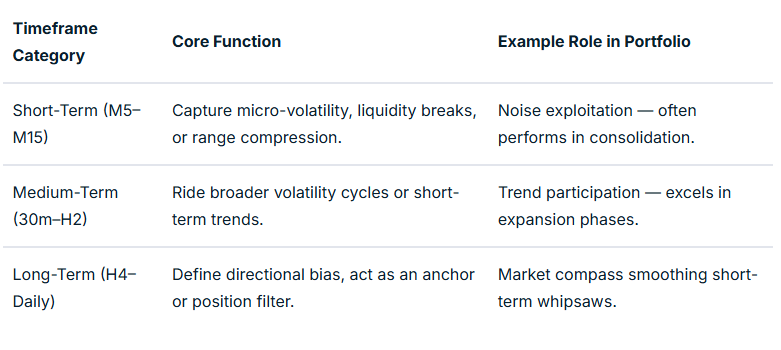
Asset Balance: Managing Systemic Correlation Risk
Running five different EAs on USDJPY might feel diversified if each uses different entry logic, even though they share the same systemic market driver.
But in an EA context, correlation measurement is not necessarily between prices, but between EA returns (equity changes) relating to specific strategies in specific market conditions.
Two EAs on the same symbol might use completely different logic and thus have near-zero correlation.
Conversely, two EAs on a different symbol may feel as though they should offer some balance, but if highly correlated in specific market conditions may not achieve your balancing aim.
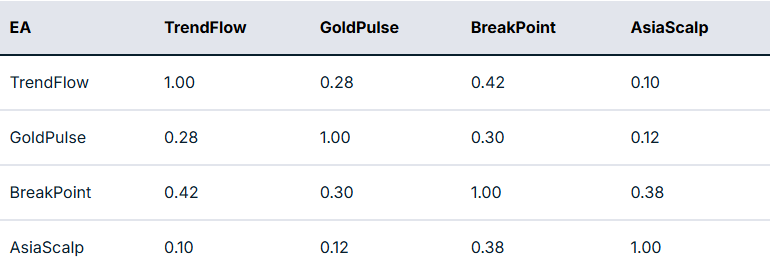
In practical terms, the next step is to take this measurement and map it to potential actionable interventions.
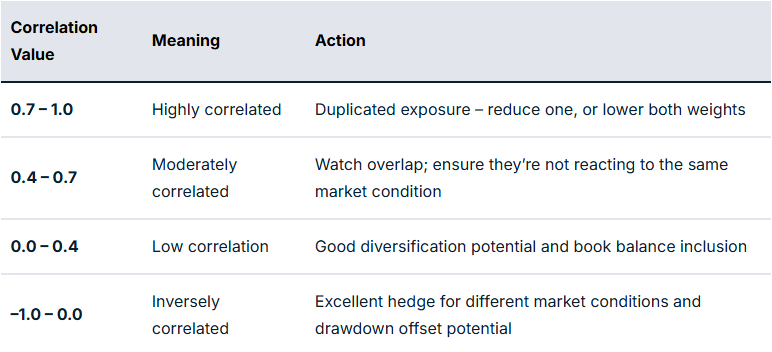
For example, if you have a EURUSD Trend EA and a GBPUSD Breakout EA with a correlation of 0.85, they are behaving like twins in performance related to specific market circumstances. And so you may want to limit exposure to some degree if you are finding that there are many relationships like this.
However, if your gold mean reversion EA correlates 0.25 compared to the rest of your book, this may offer some balance through reducing portfolio drawdown overlap.
Directional and Sentiment Balance
Markets are commonly described as risk-on or risk-off. This bias at any particular time is very likely to impact EA performance, dependent on how well balanced you are to deal with each scenario.
You may have heard the old market cliché of “up the staircase and down the elevator shaft” to describe how prices may move in alternative directions. It does appear that optimisation for each direction, rather than EAs that trade long and short, may offer better outcomes as two separate EAs rather than one catch-all.
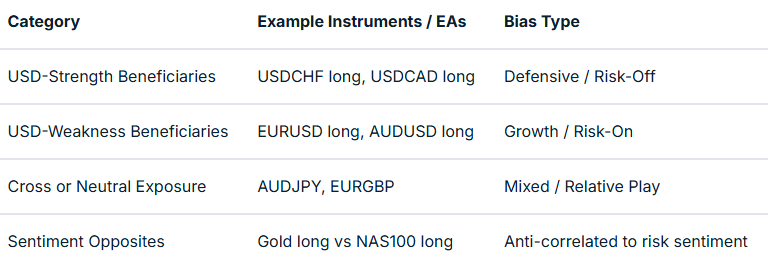
Market Regime and Volatility Balance
Trend and volatility states can have a profound impact on price action, whether as part of a discretionary or EA trading system. Much of this has a direct relationship to time of day, including the nature of individual sessions.
We have a market regime filter that incorporates trend and volatility factors in many EAs to account for this. This can be mapped and tested on a backtest and in a live environment to give evidence of strategy suitability for specific market conditions.
For example, mean reversion strategies may work well in the Asian session but less so in strongly trending markets and the higher volatility of the early part of the US session.
As part of balancing, you are asking questions as to whether you actually have EA strategies suited to different market regimes in place, or are you using these together to optimise book performance?
The table below summarises such an approach of regime vs market mapping:
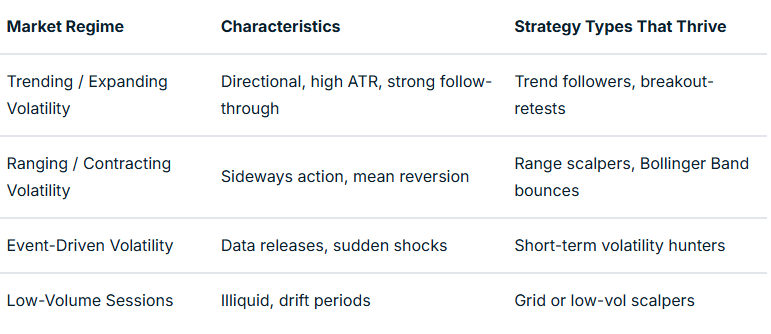
Multi-Level Analysis: From Composition to Interaction
Once your book is structured, the challenge is to turn it into something workable. An additional layer of refinement that turns theory and measurement into something meaningful in action is where any difference will be made.
This “closing the circle” is based on evidence and a true understanding of how your EAs are behaving together. It is the step that takes you to the point where automation can begin to move to the next level.
Mapping relationships with robust and detailed performance evaluation will take time to provide evidence that these are actually making a difference in meeting balancing aims.
To really excel, you should have systems in place that allow ongoing evaluation of the approaches you are using and advise of refinements that may improve things over time.
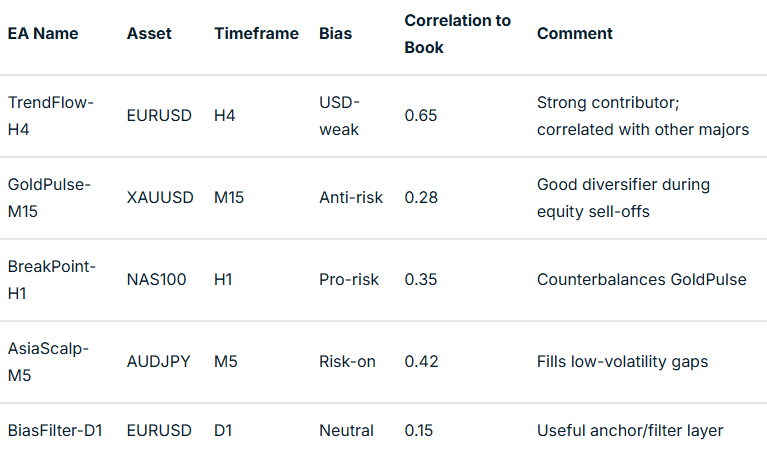
What Next? – Implementing Balance in Practice
Theory must ultimately translate into an executable EA book. A plan of action with landmarks to show progress and maintain motivation is crucial in this approach.
Defining classification tags, setting risk weights, and building monitoring dashboards are all worth consideration.
Advanced EA traders could also consider a supervisory ‘Sentinel’ EA, or ‘mothership’ approach, to enable or disable EAs dynamically based on underlying market metrics and external information integrated into EA coding decision-making.
Final Thoughts
A balanced EA portfolio is not generated by accident; it is well-thought-out, evidence-based and a continuously developing architecture. It is designed to offer improved risk management across your EA portfolio and improved trading outcomes.
Your process begins with mapping your existing strategies by number, asset, and timeframe, then expands into analysing correlations, directional bias, and volatility regimes.
When you reach the stage where one EA’s drawdown is another’s opportunity, you are no longer simply trading models but managing a system of EA systems. To finish, ask yourself the question, “Could this approach contribute to improved outcomes over time?”. If your answer is “yes,” then your mission is clear.
If you are interested in learning more about adding EAs to your trading toolbox, join the new GO EA Programme (coming soon) by contacting [email protected].


Market Character is the big sister of Market Structure. While Market Structure can show the framework of price highs and lows, Market Character reveals the behaviour of price moves in greater detail.Market character takes into account the speed of price movement, changing volatility, and the level of conviction behind the move.The combination of Break of Market Structure (BOS) and Change in Market Character (CIMC) can form a powerful duo for reading price action with greater clarity and understanding.
What is Market Character?
If market structure is about the price map over a period of time — indicating the formation of highs, lows, and swings — then market character is about the personality of price movement during the life of such a trend.Two markets can look similar in structure but may have behaved very differently over the same time period.One may have trended relatively smoothly with measured impulses to the upside and shallow retracements in price before trend continuation, whereas the other may be choppier in nature, hesitating regularly, with more frequent false breaks. This 'how it moves' is what we mean by character.Key aspects of market character include:
- Momentum: Are moves strong and one-sided, or hesitant?
- Volatility: Are price ranges expanding or compressing?
- Reaction to levels: Do support and resistance break cleanly or have frequent and prolonged pauses?
- Consistency: Are breakouts following through or reversing and forming a series of false breakouts?
- Session tone: Are there relationships associated with different times of the trading day consistent with new session times? e.g., start of European or US sessions.
BOS and CIMC in Tandem
Break of Market Structure (BOS) occurs when the old pattern of swings is violated. For example, when an uptrend shows its first lower low. Change in Market Character (CIMC) is the confirmation that the way the market moves has shifted. For example, momentum may slow, volatility may show changes, or support/resistance breaches may be more/ less compelling in nature. A BOS without a change in character is often a false alarm. Whereas a BOS followed by a CIMC is a much stronger sign of a genuine shift.
Momentum Shifts
In a strong uptrend, price rallies are invariably strong, and pullbacks or price retracements are shallow. If rallies start weakening while retracements deepen or show a weaker recovery, momentum may be fading.Why it matters: Weakening momentum makes trend continuation less reliable.How to confirm: A flattening moving average slope or MACD histograms decreasing in size or signal line crosses over the histogram level (when in a long trade and vice versa for short), suggests that momentum is running out.
Volatility Regime Change
Markets alternate between calm, controlled moves and fast, wide swings. A sudden shift is a character change.Why it matters: Stop placement and expectations must adapt to the current market normal; otherwise, trades may be prematurely closed due to increased market noise.How to confirm: ATR rising shows volatility expansion; ATR falling shows compression. Using an ATR multiple for stop placement accounts for this volatility change. Bollinger Bands placed on your chart may offer another visual cue as the bands show narrowing or widening as volatility changes.
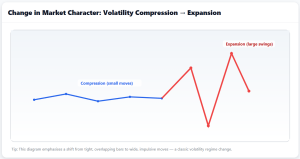
Reaction to Key Levels
Markets that have previously rewarded breakout trades may start to reject new breakouts and snap back into a previous price range. They will then limp through the level (often with reduced volume), suggesting buying or selling pressure may not have the required levels to produce a sustained move. How to confirm: The number one sign of rejection is if a candle closes back in range (even if earlier in the candle showed potential promise). Volume is also a strong indicator. If volume is lacking or price fails to follow through on a single slightly higher volume bar, then character may have shifted.
Liquidity and Session Tone
Markets behave differently at different times of day. A shift aligned with session opening times is often a change in character as new information comes around these times, and a different set of traders enter the market.Why it matters: The 'best time to trade' may change depending on the instruments and timeframe(s) you are trading, How to confirm: Session indicators or volume profiles can highlight which hours show the strongest moves. Measuring relative volume may be worth exploring, i.e., comparing the current volume with the standard profile for that day and time.
Final Thoughts
A Break of Market Structure (BOS) is your early warning that the pricing story may be changing. A Change in Market Character (CIMC) is confirmation that the behaviour has shifted, and a new set of opportunities could be developing.Using both together can give clear clues as to whether those potential opportunities add weight to your thinking or are worth trading.


Even during the strongest of market trends, prices do not move in straight lines for long.Nor do they move in random lines. Price structure has a tendency to be more like a wave, creating a visual rhythm on a chart. You can think of market structure as the framework on which all price action sits. If you can read structure clearly, it helps everything else make more sense and adds more weight to your decision-making.
Key Principles of Market Structure
Trends vs. Ranges
What you see on a chart is a reflection of sentiment toward the asset you are looking at in real time. Markets will either be trending (moving in one direction for a period of time) or ranging (moving sideways between two price points).A trend shows a strong imbalance between buyers and sellers, while a range shows balance and potential uncertainty about what should happen next.Recognising which environment the price action is in is vital. Trend strategies will often fail in a range, and range strategies will often be punished in a strong trend.
Swing Points
Swing highs and lows are fundamental pieces of price information and are the turning points of price. In an uptrend, the market trend builds with higher swing highs and higher swing lows. In a downtrend, it does the opposite. These points help traders map the direction and strength of a move. A failure to form the expected swing can be an early warning sign of change — a ‘break of market structure’.
Support and Resistance
Past swing levels often act as areas where traders make decisions. A prior swing high may act as resistance (a ceiling where price struggles to break higher), and a prior swing low may act as support (a floor where price struggles to break lower). This happens because many orders — stops, entries, or take-profits — are clustered at these levels.
Order Flow Reflection
Market structure is a reflection of order flow. Simple supply and demand based on the perception that an asset is under- or overpriced compared to its valuation.This is a battle between buyers and sellers over a succession of candles on the chosen timeframe you are looking at. If a series of higher highs is being made, it shows that sentiment-driven buying pressure is consistently strong enough to push prices to new levels. If that rhythm breaks, it tells us something has changed in the underlying supply/demand balance.
Fractality
The strongest structure (arguably) is fractal. What looks like potential noise or range forming on a daily chart may be a clear structure on a 30-minute chart, and vice versa. Imagine you have a group of 100 traders. 25 trade a 15-minute chart, 25 trade an hourly, 25 trade a 4-hourly, and 25 trade a daily.That means a confirmed trade on one timeframe has 25 interested participants, whereas if there is agreement on three, you have 75 traders about to press the entry button. In practical terms, a common approach is to use one or more higher timeframes for context and a short timeframe for entry.The image below shows an uptrend with higher highs and higher lows marked in green and red circles as the trend develops, and then a final breach of the previous swing low — a break of market structure.[caption id="attachment_712309" align="aligncenter" width="686"]
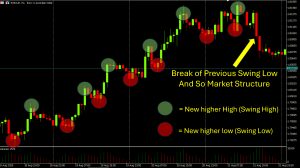
Chart showing the break of market structure[/caption]
What Is a Break of Market Structure?
A Break of Market Structure (BOS) happens when the price no longer follows the established rhythm it has been in for a period of time.Break of Market structure involves either:
- Price stops making higher highs and instead makes a lower low in an uptrend
- Price stops making lower lows and instead makes a higher high in a downtrend
This is the first sign that the “previous market story” that has brought the price to its current level may no longer apply. However, this doesn’t guarantee a full reversal. It may just see price move into a rangebound or sideways holding pattern until more information comes to the market.The bottom line is that it could be a critical clue that the balance of power between buyers and sellers has now shifted.With open trades you may have, it could be the time to consider exiting and moving into something else that is showing a new trend or continuation using the same market structure principles.
Why Is BOS Important to Traders?
Early Warning of Reversal
A BOS can be the very first sign that a trend is ending. Catching the shift early means avoiding overstaying in a trade or getting ready to position yourself for a potential trade in a new direction. Of course, this is a “get ready” and you would only take action when all confluence factors are in place as per your trading plan. i.e., don’t assume it is good until there is evidence that it is actually happening.
Liquidity Insight
Stop clusters are areas where many traders place their stop-loss orders, place profit targets, and where pending orders for entry may also be sitting. Many automated trading models are also primed to take action on a break of market structure within their coding.All of these can create pauses or reversals. Once these have all been swept away, this can be a signal of a BOS, and new momentum may be emerging.This can create a “liquidity sweep.” A liquidity sweep occurs when the price pushes temporarily beyond a swing high/low, triggering stops and attracting breakout traders, before snapping back the other way. In charting terms, you may see a one or two-candle “probe” beyond a key level before reversing. In practical terms, you can account for this in your decision-making by (for example) giving a little space below a previous swing high/low.
Helps Manage Risk
If you’re in a trend trade, a BOS against your position tells you to tighten stops, scale out, or exit. It’s a clear signal that your initial trading idea may no longer be valid, or it might be time to lock in any profits.
Framework for Strategy
Many discretionary traders and automated model builders create whole strategies around BOS events. For example, entering after a liquidity sweep and break, or waiting for retests of the broken market structure levels.
Final Thoughts
Market structure can give you a useful trading map of the evolution of sentiment behind a price move. Understanding this can help you define and act upon a break of structure, which is telling you when the map has changed (or is about to).By developing a greater understanding of the principles of structure, learning what BOS means in practice, and recognising related concepts like stop clusters and liquidity sweeps, traders can gain invaluable insights that help them take practical action to take for entry and exit decision-making.The reality is that most effective strategies will have these principles at their base. A BOS, especially when confirmed with context and market character, is one of the clearest signs of that shift.


The “Magnificent Seven” technology companies are expected to invest a combined $385 billion into AI by the end of 2025.Each of the Seven is trying to carve out its own territory in the AI landscape.Microsoft is positioning itself as the platform leader. Nvidia dominates the underlying AI infra. Google leads in research. Meta is building open-source tech. Amazon – AI agents. Apple — on-device integration. And Tesla pioneering autonomous vehicles and robots.But with these enormous sums pouring into AI, is this a winner-take-all game? Or will each of the Mag Seven be able to thrive in the AI future?[caption id="attachment_712288" align="aligncenter" width="554"]
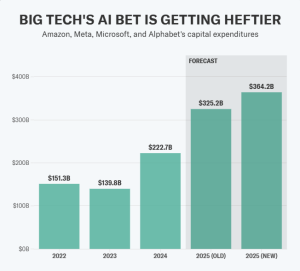
The “Big 4” tech companies' AI spending alone is forecast at $364 billion.[/caption]
Microsoft: The AI Everywhere Strategy
Microsoft has made one of the biggest bets on AI out of the Mag Seven — adopting the philosophy that AI should be everywhere.Through its deep partnership with OpenAI, of which it is a 49% shareholder, the company has integrated GPT-5 across its entire ecosystem.Key initiatives:
- GPT-5 integration across consumer, enterprise, and developer tools through Microsoft 365 Copilot, GitHub Copilot, and Azure AI Foundry
- Azure AI Foundry for unified AI development platform with model router technology
- Copilot ecosystem spanning productivity, coding, and enterprise applications with real-time model selection
- $100 billion projected AI infrastructure spending for 2025
Microsoft’s centerpiece is Copilot, which can now detect whether a prompt requires advanced reasoning and route to GPT-5's deeper reasoning model. This (theoretically) means high-quality AI outputs become invisible infrastructure rather than a skill users need to learn.However, this all-in bet on OpenAI does come with some risks. It is putting all its eggs in OpenAI's basket, tying its future success to a single partnership.[caption id="attachment_712289" align="aligncenter" width="530"]

Elon Musk warned that "OpenAI is going to eat Microsoft alive"[/caption]
Google: The Research Strategy
Google’s approach is to fund research to build the most intelligent models possible. This research-first strategy creates a pipeline from scientific discovery to commercial products — what it hopes will give it an edge in the AI race.Key initiatives:
- Over 4 million developers building with Gemini 2.5 Pro and Flash
- Ironwood TPU offering 3,600 times better performance compared to Google’s first TPU
- AI search overviews reaching 2 billion monthly users across Google Search
- DeepMind breakthroughs: AlphaEvolve for algorithm discovery, Aeneas for ancient text interpretation, AlphaQubit for quantum error detection, and AI co-scientist systems
Google’s AI research branch, DeepMind, brings together two of the world's leading AI research labs — Google Brain and DeepMind — the former having invented the Transformer architecture that underpins almost all modern large language models. The bet is that breakthrough research in areas like quantum computing, protein folding, and mathematical reasoning will translate into a competitive advantage for Google.
Today, we're introducing AlphaEarth Foundations from @GoogleDeepMind , an AI model that functions like a virtual satellite which helps scientists make informed decisions on critical issues like food security, deforestation, and water resources. AlphaEarth Foundations provides a… pic.twitter.com/L1rk2Z5DKk
— Google AI (@GoogleAI) July 30, 2025
Meta: The Open Source Strategy
Meta has made a somewhat contrarian bet in its approach to AI: giving away their tech for free. The company's Llama 4 models, including recently released Scout and Maverick, are the first natively multi-modal open-weight models available.Key initiatives:
- Llama 4 Scout and Maverick - first open-weight natively multi-modal models
- AI Studio that enables the creation of hundreds of thousands of AI characters
- $65-72 billion projected AI infrastructure spending for 2025
This open-source strategy directly challenges the closed-source big players like GPT and Claude. By making AI models freely available, Meta is essentially commoditizing what competitors are trying to monetize. Meta's bet is that if AI models become commoditized, the real value will be in the infrastructure that sits on top. Meta's social platforms and massive user base give it a natural advantage if this eventuates.Meta's recent quarter was also "the best example to date of AI having a tangible impact on revenue and earnings growth at scale," according to tech analyst Gene Munster. [caption id="attachment_712301" align="aligncenter" width="996"]

H1 relative performance of the Magnificent Seven stocks. Source: KoyFin, Finimize[/caption]However, it hasn’t been all smooth sailing for Meta. Their most anticipated release, Llama Behemoth, has all but been scrapped due to performance issues. And Meta is now rumored to be developing a closed-source Behemoth alternative, despite their open-source mantra.
Amazon: The AI Agent Strategy
Amazon’s strategy is to build the infrastructure for AI that can take actions — booking meetings, processing orders, managing workflows, and integrating with enterprise systems. Rather than building the best AI model, Amazon has focused its efforts on becoming the platform where all AI models live.Key initiatives:
- Amazon Bedrock offering 100+ foundation models from leading AI companies, including OpenAI models.
- $100 million additional investment in AWS Generative AI Innovation Center for agentic AI development
- Amazon Bedrock AgentCore enabling deployment and scaling of AI agents with enterprise-grade security
- $118 billion projected AI infrastructure spending for 2025
The goal is to become the “orchestrator” that lets companies mix and match the best models for different tasks. Amazon’s AgentCore will provide the underlying memory management, identity controls, and tool integration needed for these companies to deploy AI agents safely at scale.This approach offers flexibility, but does carry some risks. Amazon is essentially positioning itself as the middleman for AI. If AI models become commoditized or if companies prefer direct relationships with AI providers, Amazon's systems could become redundant.
Nvidia: The Infra Strategy
Nvidia is the one selling the shovels for the AI gold rush. While others in the Mag Seven battle to build the best AI models and applications, Nvidia provides the fundamental computing infrastructure that makes all their efforts possible. This hardware-first strategy means Nvidia wins regardless of which company ultimately dominates. As AI advances and models get larger, demand for Nvidia's chips only increases.Key initiatives:
- Blackwell architecture achieving $11 billion in Q2 2025 revenue, the fastest product ramp in company history
- New chip roadmap: Blackwell Ultra (H2 2025), Vera Rubin (H2 2026), Rubin Ultra (H2 2027)
- Data center revenue reaching $35.6 billion in Q2, representing 91% of total company sales
- Manufacturing scale-up with 350 plants producing 1.5 million components for Blackwell chips
With an announced product roadmap of Blackwell Ultra (2025), Vera Rubin (2026), and Rubin Ultra (2027), Nvidia has created a system where the AI industry must continuously upgrade to Nvidia’s newest tech to stay competitive.This also means that Nvidia, unlike the others in the Mag Seven, has almost no direct AI spending — it is the one selling, not buying.However, Nvidia is not indestructible. The company recently halted its H20 chip production after the Chinese government effectively blocked the chip, which was intended as a workaround to U.S. export controls.
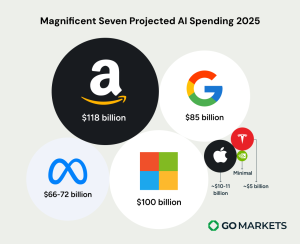
Apple: The On-Device Strategy
Apple's AI strategy is focused on privacy, integration, and user experience. Apple Intelligence, the AI system built into iOS, uses on-device processing and Private Cloud Compute to help ensure user data is protected when using AI.Key initiatives:
- Apple Intelligence with multi-model on-device processing and Private Cloud Compute
- Enhanced Siri with natural language understanding and ChatGPT integration for complex queries
- Direct developer access to on-device foundation models, enabling offline AI capabilities
- $10-11 billion projected AI infrastructure spending for 2025
The drawback of this on-device approach is that it requires powerful hardware from the user's end. Apple Intelligence can only run on devices with a minimum of 8GB RAM, creating a powerful upgrade cycle for Apple but excluding many existing users.
Tesla: The Robo Strategy
Tesla's AI strategy focuses on two moonshot applications: Full Self-Driving vehicles and humanoid robots.This is the 'AI in the physical world' play. While others in the Mag Seven are focused on the digital side of AI, Tesla is building machines that use AI for physical operations.[caption id="attachment_712292" align="aligncenter" width="537"]
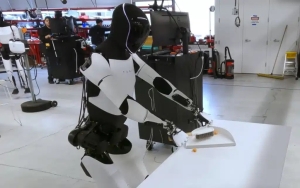
Tesla’s Optimus robot replicating human tasks[/caption]Key initiatives:
- Plans for 5,000-10,000 Optimus robots in 2025, scaling to 50,000 in 2026
- Robotaxi service targeting availability to half the U.S. population by EOY 2025
- AI6 chip development with Samsung for unified training across vehicles, robots, and data centers
- $5 billion projected AI infrastructure spending for 2025
This play is exponentially harder to develop than digital AI, and the markets have reflected low confidence that Tesla can pull it off. TSLA has been the worst-performing Mag Seven stock of 2025, down 18.37% in H1 2025.However, if Tesla’s strategy is successful, it could be far more valuable than other AI plays. Robots and autonomous vehicles could perform actual labor worth trillions of dollars annually.
The $385 billion Question
The Mag Seven are starting to see real revenue come in from their AI investments. But they're pouring that money (and more) back into AI, betting that the boom is just getting started.The platform players like Microsoft and Amazon are betting on becoming essential infrastructure. Nvidia’s play is to sell the underlying hardware to everyone. Google and Meta compete on capability and access. While Apple and Tesla target specific use cases.The $385 billion question is which of the Magnificent Seven has bet the right way? Or will a new player rise and usurp the long-standing tech giants altogether?You can access all Magnificent Seven stocks and thousands of other Share CFDs on GO Markets.


Traders love to talk about “trading the gap,” but they often skip over the first, and most critical step — defining what a gap is and why it is happening. The reality is that there are multiple types of gaps, and each can offer different opportunities and risks.The key is knowing the type of gap you are dealing with and how to respond.
What Is a Gap?
In price action terms, a gap on a chart occurs when the price jumps from one trading period to the next without any trades in between. It is most commonly seen between the close of one session and the open of the next session across multiple asset classes. Even with assets that trade 24 hours a day, gaps are often seen at the start of the next trading week.
Why Do Gaps Form?
The market is a continuous auction of buyers and sellers, but between sessions or over weekends, new information can drop that affects the market.Economic data releases, corporate earnings announcements, geopolitical developments, and unexpected supply/demand changes can all occur outside of market hours.When the market reopens, the price adjusts instantly to reflect this. If the next available trades are far from the previous close, you get a gap.In continuous markets like forex, gaps most often appear on Monday opens after weekend news, but may show up on intraday charts after unexpected events that cause major liquidity changes.
The Main Types of Gaps
Common Gaps
- Usually small.
- Occur within an established range or trend
- Most likely to fill quickly
- No strong underlying cause
- Successful trades reliant on being there at the time of occurrence
Breakaway Gaps
- Appear at the start of a new trend
- Break out from a long consolidation or key support/resistance
- Driven by strong conviction created by a big event
- Less likely to fill quickly
- Represent a genuine shift in market positioning.
Runaway (Continuation) Gaps
- Tend to occur mid-trend
- Signal momentum in the previous direction is intact
- Often act as future support or resistance levels
- May not fill until the trend is complete
Exhaustion Gaps
- Form near the end of a strong move
- Often result from a final push of buying/selling pressure.
- Price will often reverse after exhaustion gaps as the last participants are trapped
The key is to identify when and which of these four types of gaps is in play and decide whether to fade (trade against) the gap or go with it.
Why Price Often Fills Gaps
The idea of “gap filling” is generally dependent on market mechanics when a gap forms:Traders caught on the wrong side may want to exit near the pre-gap price. Large unfilled orders from before the gap can be sitting in the relevant price range. And if the gap was driven by an emotional overreaction rather than strong fundamentals, the price often reverts to normal.But although gap filling may be a common occurrence, it is not guaranteed. As with any trading approach, risk management is critical, and having a clear set of unambiguous criteria for both entry and exit is a must.Ideally, your risk management should consider the following:
- Knowing the context. Understand whether the gap is technical (range breakout) or news-driven before acting. This impacts the type and longevity of any move.
- Avoid chasing. Gap approaches are always best actioned early to provide a higher probability outcome. Not entering at all and waiting for the next opportunity is better than entering late.
- Place stops strategically. For gap fill approaches, many traders will place stops go beyond the gap extreme, for go trades, stops go just inside the gap.
- Consider the volatility of the underlying asset. Position your trade size accordingly, appropriate to the technical picture and your tolerable level of risk.
Gap Trading Strategies
Gap Fill (Fade) Strategy
This tends to offer the optimum opportunities with common and exhaustion gaps.Traders should be patient and wait for early signs across multiple short timeframes that momentum is fading after the open bar(s).The approach here is to enter in the opposite direction of the price gap move. Profit targets are usually set at a price prior to (but not at) the pre-gap price Stops may be placed just above the initial gap price, and a trailing approach to locking in profit can be used to enable early exit if conditions change.Example: If EURUSD gaps up 40 pips on a quiet Monday with no news, and price struggles to push higher in the first hour, you might consider a short trade with a profit target at Friday’s close.
Gap and Go Strategy
This approach is suited to breakaway or continuation gaps. Traders should look for a move in the gap direction after the first bar with a high-volume confirmation that the pressure is continuing in that direction.Trade entry is in the direction of the gap, and many traders would accumulate further positions should the momentum increase on continuation of a price move. Initial stops are often placed just inside the gap, giving a little space to accommodate market noise and a potential retest. Aim to capture momentum, with a trailing stop approach to ride the trend aligned with any accumulation into the positionExample: Oil price gaps up on a Monday after Friday's COT (commitment of traders) data release, suggesting a change in institutional interest and breaks out from a 1-month range on high volume.Important: Both these strategies, although they can often be seen at the same initial gap on a chart, are different in terms of entry and exit approaches. They merit a separation in terms of trading plan and should not be combined as a single approach with a variation.
Final Thoughts
Gap trading is as much about identifying context and having clear criteria for what constitutes a gap. A real edge with gap trading comes from understanding why it has formed, what type it is, and early identification of what is happening.Whether you trade gaps manually or with an EA, it is good to remember that a gap is simply the space; any opportunity will come from reading what that space is telling you.


Scaling in and out of positions is one of the most effective ways to maximise opportunity while managing risk. But it is also one of the easiest areas to let emotions take over, rather than having a clear systemised set of rules within a trading plan.If done well, scaling in can help you capitalise on strong trends without taking excessive initial risk, and scaling out can protect profits while still leaving room for the trade to run. If done poorly, it can lead to overexposure, premature exits, and a confused trading record that is difficult to evaluate.
Your Scaling Checklists
By having clearly defined rules for scaling in and out, you remove uncertainty during live market conditions, create consistency, and ensure that each of your trading actions aligns closely with your overall risk and performance objectives.Use the checklists below to help create your own rules and integrate these criteria into your written trading plan.
Scaling In Checklist:
CategoryChecklist ItemPre-Trade Plan for ScalingScaling strategy defined before entry (pyramiding, fixed lot add-on, % equity add-on, etc.) Maximum total exposure per instrument set (lots or % of account) Price level(s) or technical conditions for add-ons are pre-defined Risk per add-on is calculated, sothe combined stop placement keeps the total risk within the planTechnical & Market Conditions CheckOriginal trade is already in profit by a set buffer (e.g., +1R or above breakeven) Market structure still supports the trade thesis (trend intact, no reversal signs) Key support/resistance is not immediately ahead of the price Volatility and liquidity remain healthy — no widening spreads or news shock riskExecution RulesAdd-on triggered by pre-defined signal — technical pattern, breakout, retracement entry Stop-loss for add-on set, so the combined position risk is controlled Position size adjusted to account for existing open risk All add-ons logged in a journal with rationale and levelRisk ContainmentHave a defined cap on the number of scale-ins (e.g., max 3 total entries per trade) Combined positions’ stop reviewed and adjusted where appropriate Portfolio correlation checked — scaling in doesn’t overexpose to a single asset class
Scaling Out Checklist:
CategoryChecklist ItemPre-Defined Scaling Out RulesProfit targets for partial closes set in advance (price levels, trailing stops, % move) Minimum portion to leave running defined — e.g., 25% of position Scaling method chosen, e.g., fixed lots, % of original size, ATR-based, or structure-basedMarket & Trade Condition CheckPrice has reached the first profit-taking zone (support/resistance, measured move, fib level) Technical signs of slowing momentum or potential reversal are visible Volatility spike or news risk approaching that could threaten open profits Trade has met or exceeded the minimum R target — e.g., 2RExecution RulesPartial close executed according to plan — no hesitation or emotional overrides Stop-loss on remaining position tightened if conditions warrant Take-profit levels for the remaining position are re-evaluated after partial closePost-Scale ReviewDocument in journal: reason for scaling out, % closed, remaining size, new stop Track performance impact of scaling — did partial exits improve net profitability or reduce potential gains? Adjust future scaling-out rules based on review data
Final Thoughts
The goal of scaling in and out is not to make a trade “feel” safer or more profitable, but to execute a pre-planned sequence of actions that have the potential to enhance your overall performance and better meet your trading goals. Whether you are attempting to add to an existing position or lock in gains for a specific trade, every adjustment should be intentional, tested, and documented.This disciplined approach can help turn your scaling approaches into something of consistent benefit, rather than a hit-or-miss, heat-of-the-moment type of tactic that most traders use.


Many traders begin their exploration of indicators with the assumption that “more tools” equals “more clarity.” The result is stacking indicator after indicator into the chart in the hope that it will reveal the perfect moment for entry when everything aligns.But rather than offering clarity, it often results in conflict with some indicators suggesting “buy,” while another says “wait.”
What Are Indicators and What Are They Not?
Indicators are tools, not predictors.They don’t forecast the future, they analyse past price movement and associated variables and relationships using mathematical formulas. They cannot tell you with certainty what will happen next, eliminate risk, prevent losses, or work consistently in every market condition with every asset type.However, this does not mean they are not useful. Previous price action does have an influence on current price movement. What indicators can help with is quantifying market behaviour up to a point in time. They provide context for current price action and have a strong role in defining potential risk parameters like stops or targets.Price action should always be king for both entry and exit trading decisions. But some confluence (the level of agreement or refuting what you see in price) relating to the overall context can also be key to system development and implementation.Additionally, strong, specific, and unambiguous objective criteria can offer some clarity and consistency in action, which is crucial for performance evaluation.
What Are You Actually Measuring?
You should never use an indicator as part of your decisions unless you know what it is telling you about the market. Indicators are at their most powerful when combined with current price action and market structure (e.g., key levels).Most indicators fall into one of four core types:
1. Trend-Following Indicators
Examples: Moving Averages (MA), MACD, ADXWhat they do: Smooth price to identify direction and filter out potential market noiseHow they help: Keep you trading in the dominant direction. e.g., by checking trends on longer timeframes or through comparison of different period MA’s can give confirmation that trend may be nearing its end, changing, or has changed already.
2. Momentum Indicators
Examples: RSI, Stochastic, What they do: Measure the speed and strength of price movesHow they help: Can help spot overbought/oversold areas that mean the market may be more likely to change. Some also utilize them to look for divergence in direction versus price as a suggestion that things may be about to change.
3. Volatility Indicators
Examples: ATR, Bollinger Bands,What they do: Measure how far the price is moving within a specified chart time windowHow they help: Stop loss and take profit level placement. e.g., a multiple of current ATR may help anticipate breakouts and can be used in some mean reversion strategies on a price reversal or bounce.
4. Volume-Based Indicators
Examples: Volume Profile, Average, and relative volumeWhat they do: Indicate buying and selling activity behind price moves.How they help: Show commitment behind a move and may indicate the strength of a move or deviation from the norm.Where they fail: Limited usefulness in markets with unreliable volume data (e.g., spot FX)
Common Indicator Errors
1. Stacking Indicators That Do the Same Thing
This is probably the most common mistake people make with indicators.For example, using RSI and Stochastic at the same time —they're both momentum indicators. This leads to confirmation bias, not confidence.
2. Only Trading When Everything Aligns
Waiting for all your indicators to “line up” may delay good trades. This should not take away from having clear criteria articulated in your trading plan, but if you have a system that is too complex, you will find it becomes too hard to implement, and you end up ignoring your criteria anyway.
3. Attempting to Use Indicators to Fix a Poor System
“If I just add this one more indicator filter, I can avoid bad trades.”This is rarely the case. The primary reasons traders run into problems are that their system is poorly defined or there are problems following it. Adding yet another indicator to the many you may already have is unlikely to make any difference. This mindset leads to paralysis. Risk is part of trading — indicators refine edge, not remove risk.
4. Following Signals Without Price Action or Market Context
Blindly buying on MACD crossover or RSI below 30 not only ignores actual price but also other key factors such as market structure, news, sentiment, or time of day, all of which can have a massive impact on what happens next.
Purposeful Use of Indicators
The most effective traders simplify. They use fewer indicators but aim to use them in a better way. Here is some practical guidance that is worth considering:Use One or Two Indicators Per Function:
- One trend filter (e.g., 50 EMA)
- One volatility tool (e.g,. ATR for stops)
- One timing/momentum indicator (e.g., RSI)
This will help keep your chart clean, your strategy simpler, and your decision-making fast.Make Each Indicator Answer a Specific Question:Before you add any decision-making tool to your chart, consider what question you are trying to answer about your trading idea and which indicator serves this best.Use Indicators to Support Structure — Not Replace It:Remember that it is price that tells the story. Indicators provide extra evidence to support any price-based decision.
Indicator Audit Checklist
This 6-question checklist can help you decide whether to keep, remove, or replace an indicator on your chart.QuestionYesNoDoes this indicator provide information I don’t get elsewhere?Worth keepingLikely redundantDo I understand how it is calculated and what it is measuring?Use it with confidenceLearn it or remove itDoes it align with my trading style?RelevantMisalignedDoes it help me make faster/more confident decisions?Value-addingCluttering judgmentIs it part of a clearly defined process?PurposefulArbitraryHave I backtested or forward-tested it within my system?ProvenDangerous guesswork
Final Thoughts
Indicators are not the enemy of the trader, but it is clear that the indiscriminate use of them may be ill-advised.Consider carefully what you are going to put on your chart, making sure that you strive for clarity in your trading system processes first, and then indicators can prove to be invaluable.

